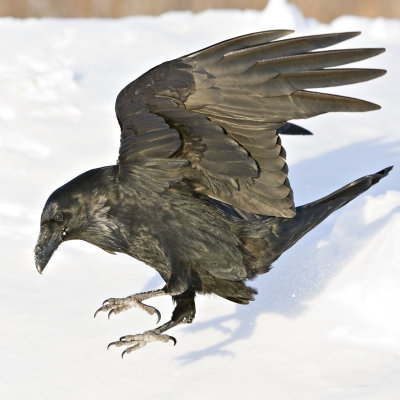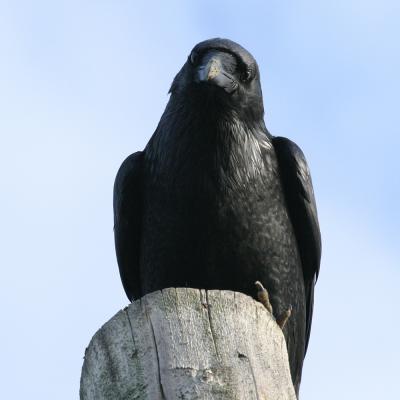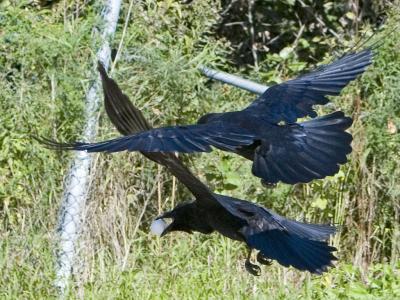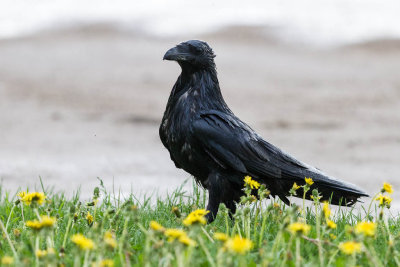Adaptation
The common raven has many characteristics that help it survive and be better adapted for its unique and widely varied habitats. These adaptations that common ravens have include both physical traits that help it when hunting our flying, as well as the incredible intelligence that this bird exudes. Without these very important adaptations it would be much harder for the common raven to live in so many habitats and be such a successful and versatile bird.
Physical
 Physical adaptations of many organisms within the animal kingdom
can be very specific amongst species. When many people think of a
giraffe what instantly comes to their mind is a long neck for
feeding on high tree limbs, or when one thinks of a
platypus they envision a billed mammal with webbed feet, with
the common raven there are not very many physical adaptations that
set it apart. Corvus corax has a large, strong, and curved
bill, which helps it grasp onto prey and be able to eat many
different kinds of food, they are larger in size which contributes
to less predation of this species, and they have large pointed wings
that allow for strong aerobatic flight and the ability to soar for
long intervals of time. Although these are extremely important
adaptations within the species Corvus corax, they are
mostly generalized due to the fact that these physical traits can
vary according to habitat or local environment. Throughout higher
altitudes including the Himalayas, the common raven tends to be
larger in body size with a larger bill size, in southern parts of
the world the common raven tends to be smaller in size with a
smaller bill, and in the Arctic, common ravens are found to have
larger bills; there is much variation amongst common ravens
throughout the world. Many of these physical differences amidst this
species can be attributed to a need to adapt in order to gather
food. The common ravens that live within the Arctic are thought to
have larger bills because they have to feed on prey larger than most
other members of their species (Goodwin 1986). This differentiation
in adaptations amongst habitats and geographical location are
incredibly important for the common raven, but they are not
something that sets this bird apart within the animal kingdom. One
of the most pronounced and important adaptations that distinguish
this bird originate with its vast intelligence.
Physical adaptations of many organisms within the animal kingdom
can be very specific amongst species. When many people think of a
giraffe what instantly comes to their mind is a long neck for
feeding on high tree limbs, or when one thinks of a
platypus they envision a billed mammal with webbed feet, with
the common raven there are not very many physical adaptations that
set it apart. Corvus corax has a large, strong, and curved
bill, which helps it grasp onto prey and be able to eat many
different kinds of food, they are larger in size which contributes
to less predation of this species, and they have large pointed wings
that allow for strong aerobatic flight and the ability to soar for
long intervals of time. Although these are extremely important
adaptations within the species Corvus corax, they are
mostly generalized due to the fact that these physical traits can
vary according to habitat or local environment. Throughout higher
altitudes including the Himalayas, the common raven tends to be
larger in body size with a larger bill size, in southern parts of
the world the common raven tends to be smaller in size with a
smaller bill, and in the Arctic, common ravens are found to have
larger bills; there is much variation amongst common ravens
throughout the world. Many of these physical differences amidst this
species can be attributed to a need to adapt in order to gather
food. The common ravens that live within the Arctic are thought to
have larger bills because they have to feed on prey larger than most
other members of their species (Goodwin 1986). This differentiation
in adaptations amongst habitats and geographical location are
incredibly important for the common raven, but they are not
something that sets this bird apart within the animal kingdom. One
of the most pronounced and important adaptations that distinguish
this bird originate with its vast intelligence.
Intelligence
 Viewed as one of the most intelligent creatures within the animal
kingdom, the common raven has the ability to learn (through
observation and problem solving), memorize, vocalize and understand
complex information.
Viewed as one of the most intelligent creatures within the animal
kingdom, the common raven has the ability to learn (through
observation and problem solving), memorize, vocalize and understand
complex information.
Corvus corax is very well known for its vocals as it can make a wide array of sounds for a number of situations. They use this ability to communicate complex ideas and pass on messages to other members of their species. Scientific experiments have documented the fact that these messages are influential in acquiring food as well as solidifying dominance amongst these birds. In a particular experiment performed by Bernd Heinrich, common ravens were acknowledged to use their ability of vocalization to “yell” to other members of its species. This technique of “yelling” was seen to entice other ravens into the same proximity, and was also performed when Corvus corax approached or came into contact with food, such as an animal carcass. When observing the common raven feeding in these “recruited” groups, Heinrich was able to gather that the most vocal ravens were the ones with the most dominant social statues. The most dominant ravens would “yell” frequently while at the food source, and in turn succeeded in suppressing the “yells” of the less dominant ravens. What this experiment shows is that there is a complex base of information passed amongst common raven vocals (Heinrich 1991). Messages such as the ones analyzed in Heinrich’s experiment can be passed along while the common raven is scavenging or hunting, but a lot of messages amongst these birds have been seen to take place at their roosts or nests. By placing beads within sheep carcasses in Northern Wales, scientists were able to track where common ravens from a particular roost were feeding and which birds were roosting together. These scientists counted the variety and color of these beads to be within similar locations and ranges of the nests and deduced from this information that within their roots and nests, common ravens will congregate together, and while they are there, they will provide information to other ravens that there is food nearby (Wright 2003). Corvus corax is extremely smart and will intelligently pass on messages to other common ravens in order to maximize food consumption and distribution of food. They do this through a number of complex vocals, making their intelligence through vocalization a very important adaptation.
Click Here to sample some common raven vocals!
Click Here in order to experience more common raven vocals!
Common ravens use their intelligence to communicate messages to
other members of its species, but with their intelligence, they are
also seen to use it as a form of learning. In order to test the
problem solving ability of the common raven, studies were performed
with baited strings. Common ravens of both juvenile and adult ages
were presented with meat tied to a string away from any human
presence, what researchers witnessed was a number of methods used by
the birds to gain access to the food, they would most interestingly
pull on the string to test the availability of the meat. When shooed
away, they would drop the meat because they “knew” that it was
attached to a string. When they were given the baited string in
close association with a human presence, the common ravens did not
have the time to analyze the string and would try to fly away with
the meat when shooed. This shows that when given time, ravens can
understand and solve complex problems (Heinrich 2011).
species, but with their intelligence, they are
also seen to use it as a form of learning. In order to test the
problem solving ability of the common raven, studies were performed
with baited strings. Common ravens of both juvenile and adult ages
were presented with meat tied to a string away from any human
presence, what researchers witnessed was a number of methods used by
the birds to gain access to the food, they would most interestingly
pull on the string to test the availability of the meat. When shooed
away, they would drop the meat because they “knew” that it was
attached to a string. When they were given the baited string in
close association with a human presence, the common ravens did not
have the time to analyze the string and would try to fly away with
the meat when shooed. This shows that when given time, ravens can
understand and solve complex problems (Heinrich 2011).
Click Here to see raven intelligence in action!
Click Here to see more raven intelligence tests!
Common ravens can communicate messages and have the ability to
learn and understand problems; interestingly enough, they have also
been seen to use tools for their personal benefit as well. Common
ravens have been documented dropping stones on the heads of
predators. Instead of trying to directly attack or frighten a
predator that is near their nest, common ravens may intelligently
protect themselves as well as their young by flying by predators and
dropping
 stones on them (Heinrich 2011). Common ravens not only use
non-edible objects as tools for protection, but to build strong
relationships with other common ravens as well. In the Northern Alps
of Austria, the common raven was documented using non-edible objects
such as sticks and moss to entice potential mating partners and
create relationships. This process of using “referential gestures”
was thought to be only used by primate species, but what these
observations showed is that common ravens have very more intricate
social interactions than what was previously thought (Pika 2011).
The ability to use tools such as these rocks and non-edible objects
can be useful in lengthening a common raven’s life as well as
influencing potential mates and relationships.
stones on them (Heinrich 2011). Common ravens not only use
non-edible objects as tools for protection, but to build strong
relationships with other common ravens as well. In the Northern Alps
of Austria, the common raven was documented using non-edible objects
such as sticks and moss to entice potential mating partners and
create relationships. This process of using “referential gestures”
was thought to be only used by primate species, but what these
observations showed is that common ravens have very more intricate
social interactions than what was previously thought (Pika 2011).
The ability to use tools such as these rocks and non-edible objects
can be useful in lengthening a common raven’s life as well as
influencing potential mates and relationships.
The common raven is very intelligent, because of this adaptation they have a great memory. Having a good memory is very important to this organism, because it allows them to find the food and non-edible that they have stored or cached away (Bugnyar 2007).
Go to Nutrition to learn more about food caching and what the common raven eats!
Back to Top
Back to Homepage
